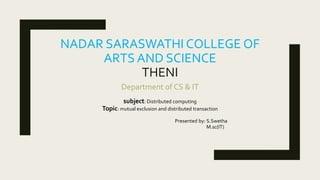
Distributed computing
- 1. NADAR SARASWATHI COLLEGE OF ARTS AND SCIENCE THENI Department of CS & IT subject: Distributed computing Topic: mutual exclusion and distributed transaction Presented by: S.Swetha M.sc(IT)
- 2. Mutual exclusion in distributed system Mutual exclusion is a concurrency control property which is introduced to prevent race conditions. It is the requirement that a process can not enter its critical section while another concurrent process is currently present or executing in its critical section i.e only one process is allowed to execute the critical section at any given instance of time.
- 3. Mutual exclusion in single computer system Vs. distributed system: In single computer system, memory and other resources are shared between different processes.The status of shared resources and the status of users is easily available in the shared memory so with the help of shared variable (For example: Semaphores) mutual exclusion problem can be easily solved.
- 4. Continue…… In Distributed systems, we neither have shared memory nor a common physical clock and there for we can not solve mutual exclusion problem using shared variables.To eliminate the mutual exclusion problem in distributed system approach based on message passing is used.
- 5. A site in distributed system do not have complete information of state of the system due to lack of shared memory and a common physical clock.
- 7. Requirements of Mutual exclusion Algorithm: ■No Deadlock: Two or more site should not endlessly wait for any message that will never arrive.
- 8. ■No Starvation: Every site who wants to execute critical section should get an opportunity to execute it in finite time. Any site should not wait indefinitely to execute critical section while other site are repeatedly executing critical section…
- 9. ■Fairness: Each site should get a fair chance to execute critical section. Any request to execute critical section must be executed in the order they are made i.e Critical section execution requests should be executed in the order of their arrival in the system.
- 10. ■ FaultTolerance: In case of failure, it should be able to recognize it by itself in order to continue functioning without any disruption. Solution to distributed mutual exclusion: As we know shared variables or a local kernel can not be used to implement mutual exclusion in distributed systems. Message passing is a way to implement mutual exclusion. Below are the three approaches based on message passing to implement mutual exclusion in distributed systems:
- 11. 1. Token BasedAlgorithm: ■ A unique token is shared among all the sites. ■ If a site possesses the unique token, it is allowed to enter its critical section ■ This approach uses sequence number to order requests for the critical section. ■ Each requests for critical section contains a sequence number.This sequence number is used to distinguish old and current requests. ■ This approach insures Mutual exclusion as the token is unique ■ Example: ■ Suzuki-Kasami’s BroadcastAlgorithm
- 12. Non-token based approach: ■ A site communicates with other sites in order to determine which sites should execute critical section next.This requires exchange of two or more succeive round of messages among sites. ■ This approach use timestamps instead of sequence number to order requests for the critical section. ■ When ever a site make request for critical section, it gets a timestamp. Timestamp is also used to resolve any conflict between critical section requests. ■ When ever a site make request for critical section, it gets a timestamp. Timestamp is also used to resolve any conflict between critical section requests.
- 13. Continue….. ■ All algorithm which follows non-token based approach maintains a logical clock. Logical clocks get updated according to Lamport’s scheme ■ Example: ■ Lamport's algorithm, Ricart–Agrawala algorithm
- 14. Quorum based approach: ■ Instead of requesting permission to execute the critical section from all other sites, Each site requests only a subset of sites which is called a quorum. ■ Any two subsets of sites or Quorum contains a common site. ■ This common site is responsible to ensure mutual exclusion ■ Example: ■ . Maekawa’sAlgorithm
- 15. Distributed transaction: ■ A Distributed transaction is a set of operations on data that is performed across two or more data repositories (especially databases). It is typically coordinated across separate nodes connected by a network, but may also span multiple databases on a single server. ■ There are two possible outcomes: 1) all operations successfully complete, or 2) none of the operations are performed at all due to a failure somewhere in the system. In the latter case, if some work was completed prior to the failure, that work will be reversed to ensure no net work was done.
- 16. ■ The operation known as a “two-phase commit” (2PC) is a form of a distributed transaction. “XA transactions” are transactions using the XA protocol, which is one implementation of a two-phase commit operation.
- 17. ■ Distributed transactions have the same processing completion requirements as regular database transactions, but they must be managed across multiple resources, making them more challenging to implement for database developers.The multiple resources add more points of failure, such as the separate software systems that run the resources (e.g., the database software), the extra hardware servers, and network failures.This makes distributed transactions susceptible to failures, which is why safeguards must be put in place to retain data integrity. ■ For a distributed transaction to occur, transaction managers coordinate the resources (either multiple databases or multiple nodes of a single database).The transaction manager can be one of the data repositories that will be updated as part of the transaction, or it can be a completely independent separate resource that is only responsible for coordination.The transaction manager decides whether to commit a successful transaction or rollback an unsuccessful transaction, the latter of which leaves the database unchanged.